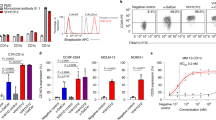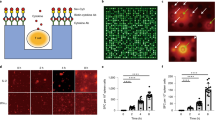Abstract
Cell–cell adhesion is essential for many immunological functions1–4, including interaction of cytotoxic T lymphocytes (CTLs) with their targets5–8. We have explored CTL-target interactions using well-characterized cloned human CTLs9,10. Conjugate formation between these CTLs and many antigen-negative targets is almost as efficient as with specific target cells, but does not lead to target-cell lysis. Thus, on specific target cells, adhesion by antigen-independent pathways may occur concurrently with or precede antigen recognition. The molecules LFA-1, CD2 (Til, LFA-2) and LFA-3 have been shown11–15 to be involved in human CTL conjugation with and lysis of specific target cells. Here we describe monoclonal antibody inhibition studies using individual monoclonal antibodies and mixes which demonstrate (1) that LFA-1, CD2 and LFA-3 are involved in antigen-independent conjugate formation; and (2) suggest that CD2 and LFA-3 are involved in one pathway and LFA-1 in another. We confirmed the existence of distinct pathways by the demonstration that LFA-1-dependent adhesion requires divalent cations and is temperature-sensitive whereas CD2- and LFA-3-dependent adhesion does not require divalent cations and is temperature-insensitive. Together with previous data, our studies suggest that CD2 on the effector interacts with LFA-3 as its ligand on targets.
This is a preview of subscription content, access via your institution
Access options
Subscribe to this journal
Receive 51 print issues and online access
$199.00 per year
only $3.90 per issue
Buy this article
- Purchase on Springer Link
- Instant access to full article PDF
Prices may be subject to local taxes which are calculated during checkout
Similar content being viewed by others
References
Rouse, R. V., Reichert, R. A., Gallatin, W. M., Weissman, I. L. & Butcher, E. C. Am. J. Anat. 170, 391–405 (1984).
Bjerknes, M., Cheng, H. & Ottaway, C. A. Science 231, 402–405 (1986).
Bell, G. I. Immun. Today 4, 237–240 (1983).
Inaba, K. & Steinman, R. M. J. exp. Med. 163, 247–261 (1986).
Berke, G. Prog. Allergy 27, 69–133 (1980).
Bongrand, P., Pierres, M. & Golstein, P. Eur. J. Immun. 13, 424–429 (1983).
Martz, E. Contemp. Top. Immunobiol. 7, 301–361 (1977).
Bonavida, B., Bradley, T. P. & Grimm, E. A. Immun. Today 4, 196–200 (1983).
Biddison, W. E., Rao, P. E., Talle, M. A., Goldstein, G. & Shaw, S. J. exp. Med. 159, 783–797 (1984).
Shaw, S., Goldstein, G., Springer, T. A. & Biddison, W. E. J. Immun. 134, 3019–3026 (1985).
Krensky, A. M. et al. J. Immun. 131, 611–616 (1983).
Sanchez-Madrid, F. et al. Proc. natn. Acad. Sci. U.S.A. 79, 7489–7493 (1982).
Hildreth, J. E., Gotch, F. M., Hildreth, P. D. & McMichael, A. J. Eur. J. Immun. 13, 202–208 (1983).
Martin, P. J. et al. J. Immun. 131, 180–185 (1983).
Krensky, A. M., Robbins, E., Springer, T. A. & Burakoff, S. J. J. Immun. 132, 2180–2182 (1984).
Shaw, S., Kavathas, P., Pollack, M. S., Charmot, D. & Mawas, C. Nature 293, 745–747 (1981).
Luce, G. G., Gallop, P. M., Sharrow, S. O. & Shaw, S. BioTechniques 3, 270–272 (1985).
Segal, D. M. & Stephany, D. A. Cytometry 5, 169–181 (1984).
Springer, T. A., Thompson, W. S., Miller, L. J., Schmalstieg, F. C. & Anderson, D. C. J. exp. Med. 160, 1901–1918 (1984).
Goldstein, M., Hoxie, J., Zembryki, D., Matthews, D. & Levinson, A. I. Blood 66, 444–446 (1985).
Hamann, A., Jablonski-Westrich, D., Raedler, A. & Thiele, H. G. Cell. Immun. 86, 14–32 (1984).
Galili, U., Galili, N., Vanky, F. & Klein, E. Proc. natn. Acad. Sci. U.S.A. 75, 2396–2400 (1978).
Van de Rijn, M. et al. Science 226, 1083–1085 (1984).
Barbosa, J. A. et al. Proc. natn. Acad. Sci. U.S.A. 81, 7549–7553 (1984).
Spits, H. et al. Science 403–405 (1986).
Martz, E. J. Cell Biol. 84, 584–598 (1980).
Wolf, L. S., Tuck, D. T., Springer, T. A., Haynes, B. F. & Singer, K. H. Clin. Res. 34, 674A (1986).
Edelman, G. M. A. Rev. Biochem. 54, 135–169 (1985).
Gromkowski, S. H., Krensky, A. M., Martz, E. & Burakoff, S. J. J. Immun. 134, 244–249 (1985).
Golde, W. T., Kappler, J. W., Greenstein, J., Malissen, B., Hood, L. & Marrack, P. J. exp. Med. 161, 635–640 (1985).
Rothlein, R. & Springer, T. A. J. exp. Med. 163, 1132–1149 (1986).
Shaw, S., Duquesnoy, R. J. & Smith, P. L. Immunogenetics 14, 153–162 (1981).
Kirchner, H., Tosato, G., Blaese, M., Broder, S. & Magrath, I. T. J. Immun. 122, 1310–1313 (1979).
Hildreth, J. E. K. & August, J. T. J. Immun. 134, 3272–3280 (1985).
Rubin, L. A., Kurman, C. C., Biddison, W. E., Goldman, N. D. & Nelson, D. L. Hybridoma. 4, 91–102 (1985).
Rothbein, R., Dustin, M. L., Marlin, S. D., Springer, T. A. J. Immun. 137, 1270–1274 (1986).
Author information
Authors and Affiliations
Rights and permissions
About this article
Cite this article
Shaw, S., Ginther Luce, G., Quinones, R. et al. Two antigen-independent adhesion pathways used by human cytotoxic T-cell clones. Nature 323, 262–264 (1986). https://doi.org/10.1038/323262a0
Received:
Accepted:
Issue Date:
DOI: https://doi.org/10.1038/323262a0
This article is cited by
-
Tumor-derived GDF-15 blocks LFA-1 dependent T cell recruitment and suppresses responses to anti-PD-1 treatment
Nature Communications (2023)
-
CRISPR activation screen identifies BCL-2 proteins and B3GNT2 as drivers of cancer resistance to T cell-mediated cytotoxicity
Nature Communications (2022)
-
Upregulated CD58 is associated with clinicopathological characteristics and poor prognosis of patients with pancreatic ductal adenocarcinoma
Cancer Cell International (2021)
-
Reduced potency of cytotoxic T lymphocytes from patients with high-risk myelodysplastic syndromes
Cancer Immunology, Immunotherapy (2016)
-
Increased effector–target cell conjugate formation due to HLA restricted specific antigen recognition
Immunologic Research (2009)
Comments
By submitting a comment you agree to abide by our Terms and Community Guidelines. If you find something abusive or that does not comply with our terms or guidelines please flag it as inappropriate.



